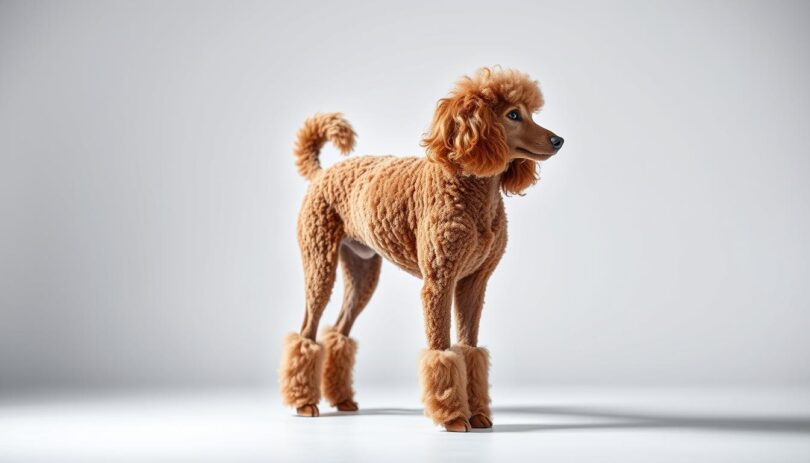There’s something magical about how a perfectly styled coat can transform your furry companion’s presence. Whether they’re prancing through the park or curling up at home, their look becomes an extension of their playful spirit and elegance. For decades, creative grooming has turned these dogs into living art—a tradition that continues to evolve with fresh twists.
From the polished sophistication of show-ring designs to relaxed everyday trims, each cut tells a story. Historical techniques, like sculpting the body hair into rounded patterns, laid the groundwork for today’s bold styles. Modern trends now blend practicality with flair, ensuring comfort while highlighting their unique personality.
Events like the Westminster Kennel Club Dog Show have redefined grooming standards, inspiring pet owners to experiment. But beyond aesthetics, the right style supports coat health and mobility. This guide explores timeless and trendy approaches, offering tips for managing length, shaping legs, and crafting eye-catching topknots.
You’ll discover how to balance tradition with innovation—whether aiming for a showstopping appearance or a low-maintenance look. Let’s dive into techniques that keep your companion’s coat healthy, stylish, and utterly unforgettable.
The Evolution of the poodle haircut: From Utility to Glamour
Centuries ago, these curly-coated companions weren’t groomed for show rings but for survival. Their distinctive trims served practical needs: keeping joints warm during icy retrieves while reducing drag in water. This balance between function and form laid the foundation for today’s artistic styles.
Historical Styles and Their Origins
In the 1600s, hunters prioritized efficiency. They shaved hindquarters to improve swimming but left chest hair for insulation. Thick tufts around leg joints protected vital areas from cold—a design still mirrored in modern cuts. Breed standards later formalized these patterns, ensuring consistency across generations of poodles.
Impact of Grooming Innovations Since the 1940s
Post-WWII tool advancements allowed precise sculpting. Electric clippers replaced manual shears, enabling groomers to create dramatic pom-poms and tapered legs. By the 1960s, dog shows turned functional trims into runway-worthy art. Yet even flashy styles retained elements like a fuller chest—proving beauty and practicality could coexist.
Innovative Grooming Ideas for Every Poodle
Creative grooming blends artistry with practicality, offering fresh ways to showcase your companion’s charm. Today’s trends focus on balancing playful aesthetics with manageable upkeep, ensuring every trim suits both lifestyle and personality.
Teddy Bear Toy Poodle Haircut Trends
This whimsical style transforms smaller breeds into cuddly companions. Rounded facial contours and fluffy ears soften their appearance, while a uniform 1–2 inch coat length maintains a plush texture. Ideal for Toy varieties, it requires monthly trims and daily brushing to prevent matting.
Use thinning shears to create feathery layers around the paws. Pair it with a rounded topknot for added character. Groomers recommend this look for puppies, as it’s forgiving during growth phases.
Modified Continental: A Contemporary Twist
Traditional Continental cuts featured intricate patterns, but modern versions simplify maintenance. The updated design keeps the chest and leg hair shorter while preserving signature “bracelets” around the ankles. Body hair is clipped to ½ inch, reducing grooming time by 40% compared to classic styles.
This approach works well for active dogs. It prevents debris buildup during outdoor adventures while maintaining elegance. For step-by-step guidance, explore these trending poodle trims that balance form and function.
Trendy Cut Accents: Styling Ears, Legs, and Topknots
Styling a poodle's coat is like sculpting living art—every snip highlights their elegance. Strategic accents on ears, legs, and topknots create visual harmony. These details transform everyday trims into personalized statements.
Playing with Length and Texture Accents
Shorter body cuts paired with longer leg hair draw attention to movement. For ears, leave 1–2 inches of hair to frame the face. Use thinning shears to soften edges for a natural flow.
Topknots add drama. Secure hair above the eyes with a band, then trim to match the dog’s proportions. A rounded shape suits sporty looks, while a sleek ponytail elevates formal styles.
For texture, layer shears create depth in key areas. Try a ½-inch clip on the torso but leave “bracelets” around ankles. This works for best poodle mixes, blending practicality with flair.
Balance matters. Keep leg hair short enough to avoid matting but long enough to emphasize grace. Regular brushing maintains the coat’s bounce between trims. Whether prepping for a walk or show ring, these accents adapt effortlessly.
Behind the Show Ring: Poodle Grooming and Culture
Behind the glitz of dog shows lies a world where every snip shapes history. Grooming here isn’t just about beauty—it’s a craft steeped in tradition, debated in headlines, and perfected under spotlights. From controversial critiques to celebrated champions, the culture surrounding these styles reveals deeper stories.
Insights from Dog Shows and Celebrity Grooming Secrets
Westminster winners like Sage (2020) and Siba (2019) showcase meticulous cuts that honor breed standards. Yet CNN’s John Berman once called such styles “elitist,” sparking debates. Groomers counter that even extravagant looks retain functional elements—like shorter body hair for mobility.
Dual champions, like GCHP CH Brighton Minimoto, prove style and performance coexist. Their trims balance flowing leg hair with clipped torsos, allowing agility in competitions. The Modified Continental cut, popularized in field trials, now influences everyday styles with its shorter coat and signature ankle tufts.
Breed guidelines still drive trends. Official documents specify precise lengths for the head, topknot, and legs. While media often focuses on drama, enthusiasts see grooming as a tribute to the dog’s heritage—a blend of art and purpose that continues evolving.
Wrapping Up: Celebrating Your Poodle’s Unique Look
From water retrievers to runway stars, these curly-coated companions have redefined canine style through the ages. Their journey—from functional trims protecting joints in icy waters to today’s artistic expressions—shows how grooming bridges heritage and creativity.
Modern techniques let you highlight your dog’s best features. Whether sculpting a sleek topknot or keeping leg tufts playful, every cut should enhance comfort while celebrating personality. Breed standards offer guidance, but innovation thrives when you tailor styles to your pet’s unique body shape and lifestyle.
Don’t hesitate to experiment. Try blending classic patterns like the Continental with shorter body clips for easier upkeep. Professional groomers can refine details, but home trimming tools make it simple to maintain key accents between visits.
Ultimately, a well-balanced coat does more than turn heads—it reflects your companion’s spirited charm. By honoring their history and embracing fresh ideas, you create a look that’s timeless yet unmistakably theirs. After all, true elegance starts from within.
FAQ
Are shorter cuts better for active dogs?
Trimming hair short on the body and legs reduces debris buildup during outdoor activities. Many owners pair a sporty torso length with playful pompons on the tail or ankles for a balanced, low-maintenance look.
Do puppies require different grooming techniques?
Start with gradual introductions to clippers and handling. Initial trims focus on hygiene areas like paw pads and face shaping. Full stylized cuts are typically introduced after six months as the adult coat develops.











Leave a Comment